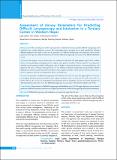Please use this identifier to cite or link to this item:
https://hdl.handle.net/20.500.14356/1357| Title: | Assessment of Airway Parameters for Predicting Difficult Laryngoscopy and Intubation in a Tertiary Center in Western Nepal |
| Authors: | Lakhe, Gajal Poudel, Hari Adhikari, Krishna Murari |
| Citation: | LakheG., PoudelH., & AdhikariK. M. (2020). Assessment of Airway Parameters for Predicting Difficult Laryngoscopy and Intubation in a Tertiary Center in Western Nepal. Journal of Nepal Health Research Council, 17(4), 516-520. https://doi.org/10.33314/jnhrc.v17i4.2267 |
| Issue Date: | 2019 |
| Publisher: | Nepal Health Research Council |
| Article Type: | Original Article |
| Keywords: | Difficult laryngoscopy and intubation screening tests upper lip bite test |
| Series/Report no.: | Oct-Dec, 2019;2267 |
| Abstract: | Abstract Background: The screening tests used for pre-operative evaluation of airway to predict difficult laryngoscopy and intubation have variable diagnostic accuracy. The unanticipated poor laryngeal view is gold standard for defining difficult intubation. We aimed to find out the prevalence of difficult laryngoscopy and intubation, which airway parameter better predicts difficult intubation and whether difficult laryngoscopy is associated with difficult intubation or not. Methods: This analytic cross sectional study was conducted in 665 ASA I/II adult patients, aged 18-65, without obvious airway pathology undergoing elective surgery under general anesthesia. The pre-operative screening tests included mouth opening, modified mallampatti, ratio of height to thyromental distance, sternomentaldistance and upper lip bite test. Cormack-Lehane grade III/ IV was defined as difficult laryngoscopy and potentially difficult intubation. Sensitivity, specificity, positive predictive value, negative predictive value, accuracy and area under curve at 95% confidence interval was calculated for all five screening tests. Results: The prevalence of difficult laryngoscopy and intubation was 6.6% (44 cases). The upper lip bite test because of its highest specificity, positive predictive value, negative predictive value, accuracy and area under curve (99.7%; 93.9%; 99.7%; 95.2%; 85.1% respectively) with moderate level of sensitivity (70.5%) was better predictor of difficult intubation than other tests. The difficult laryngoscopy was associated with difficult intubation (p=0.00). Conclusions: The prevalence of difficult laryngoscopy and intubation was 6.6%.The upper lip bite test was a better predictor of difficult intubation and there was a significant association of difficult laryngoscopy with difficult intubation. Keywords: Difficult laryngoscopy and intubation; screening tests; upper lip bite test. |
| Description: | Original Article |
| URI: | http://103.69.126.140:8080/handle/20.500.14356/1357 |
| ISSN: | Print ISSN: 1727-5482; Online ISSN: 1999-6217 |
| Appears in Collections: | Vol. 17 No. 4 Issue 45 Oct-Dec 2019 |
Files in This Item:
| File | Description | Size | Format | |
|---|---|---|---|---|
| 2267-Manuscript-13239-1-10-20200121.pdf | Fulltext Download | 876.59 kB | Adobe PDF |  View/Open |
Items in DSpace are protected by copyright, with all rights reserved, unless otherwise indicated.
